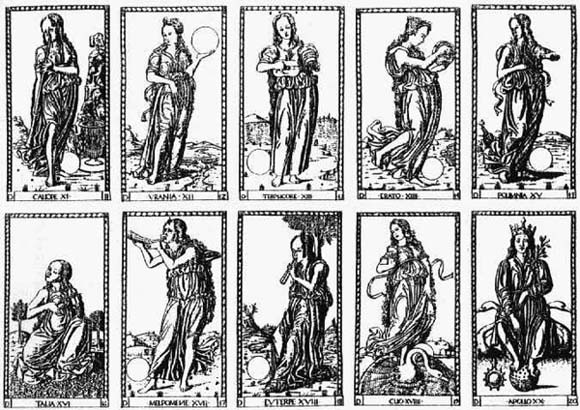|
White Moon Gallery Presents:
The Muses
by Kelly Houser


The History of the Muses
The origin of the nine classical Greek Muses is a long and tangled tale. It is unclear when the worship of The Muses first appeared. Traditionally, it is said that The Muses were the daughters of Zeus, born before he married Hera, after he spent nine nights with Mnemosyne. Over time, she gave birth to nine daughters: Calliope, Clio 1, Melpomene, Euterpe, Erato 3, Terpsichore 1, Urania 2, Thalia 2, and Polymnia. The tradition of the nine Muses had evolved from many older versions that begin with just 3 Muses. Gradually, the number of Muses began to grow until the tradition of The Muses was settled into the nine that we know today.
The Muses were said to have been born at the foot of Mount Olympus in Pieria. Their worship eventually flowed into the areas of Mount Helicon and Mount Parnassus. The worship of The Muses evolved around the central idea that they (The Muses) governed song, poetry, and inspiration. Ephialtes and Otus, who also founded Ascra, were the first to sacrifice on Helicon to the Muses and to call the mountain sacred to the Muses. Sacrifices to the Muses consisted of libations of water, milk, or honey. The Muses were much beloved by poets, musicians and artists they were said to inspire and in the 6th Century B.C.E., the “Mouseai” festivals began in famous Valley of the Muses.

Valley of the Muses
Thespies, Slopes of Mt. Helicon
The Muses also appear to have been favorites of the Olympian Gods. The chief deity they are associated with is Apollo, the Sun God. Apollo is often called Apollo Musagetes, as he was believed to “lead” the choir of Muses. The Muses were also involved in a musical battle with the Sirens. The Muses were victorious and made victory crowns out of the Siren feathers. The Muses were endowed with the same fiery temper that most Olympian Gods possessed, although most of the tales of interaction between The Muses and the other deities were non-confrontational. Venus is said to have had a particular fondness of The Muses, which is depicted in the painting below.

“The Mirror of Venus”
By Edward Burne-Jones
1870-1876
The ideology of The Muses endured thought the ages, with references to them appearing in plays, sonnets, novels, paintings, plays and more. The Muses gained in popularity during the Renaissance. Paintings, like the one above, depicting The Muses in various settings were produced in some proliferation during this time period. The Muses were also popular decoration for Renaissance Tarot Decks. A picture of one of the decks is below.

A Tarot Deck Depicting the Nine Muses (Renaissance Era)
The influence of The Muses can be seen in modern times as well. In the Vatican, a special room is dedicated to Them called Musei Vaticani or The Room of The Muses. Statues of The Muses line the room and offer inspiration to all who enter.

Musei Vaticani

What is Sacred The Muses and How to Worship Them.
Art, crafts, music, science, history and libraries are all sacred to The Muses. Unfortunately, no information has been past on as to how exactly The Muses were worshipped in Ancient Greece. The only information we have is that libations of milk, honey and water were poured out when honoring Them in the various locations. However, those who seek to honor The Muses can create new modes of worship. In her book Goddess Bless! Divine Affirmations, Prayers, and Blessings, Sirona Knight offers several hymns and chants dedicated to each of the nine Muses. Knight lists each Muse, her attributes (each Muse was said to govern a different aspect of that which is synonymous with The Muses) and a chant or hymn dedicated to her. For example, if you are lacking “creative fire” as Knight puts it, call upon Calliope, The Muses associated with creative passion and epic poetry. Knight suggests the following chant:
Oh fair One, Lady of poets,
Grant me your blessing
So my words shall be divine
Grant me your blessing
Let my creations be inspired by you,
Here and now and forevermore.
For a more general honoring of The Muses, Knight suggests you might invoke Polyhymnia, whose name means “many hymns” with the following chant:
Praise be to the Goddess
Who is all things to all people
Today I sing Her song
So all will know of Her Greatness
She is the Earth
She is the Wind
She is the Sun
She is the Rain
May She bless me with Her melody
And bring divine harmony
Into my life, now and forevermore.
Knight also recommends that we call upon The Muses when we have times of need as well. She suggests invoking Melpomene who is The Muse of tragedies and songs of mourning, with the following chant:
Goddess, please help me through this period of life
Grant me your loving strength and help me see the light
Even when things are confusing and tragic
Help me to see beyond all of my sadness and pain
To a time when everything is brighter
And in creative harmony with the Divine.
I like to call upon The Muses as my inspirational librarians. Often I am in a local bookstore and there is something specific I am seeking, whether it be herbal information, help creating a spell, etc. Sometimes, what I need doesn’t seem to be readily apparently amongst all of the books on the shelves. When this happens, I call upon my library muse to guide me to the book that contains the information I am seeking. It doesn’t require any special set-up, just repeat it a few times when you need it and see how it works for you!
Calling on Your Library Muse.
Library Muse, hear me speak
Lead me to the book I seek,
Knowledge needed, knowledge sought,
End my search with this thought!
Ritual Seeking Creativity
When my creative juices seem to be running low, I often perform the following creativity ritual. It’s really simple and works fabulously.
To perform this ritual, you will need the following items:
1 purple and 1 silver candle of any size
Oil and incense of your choice
1 small art project. This can be a page torn out of a child’s coloring book, a project you have been trying to get started for a while, a Yule ornament that needs decorating – basically anything creative.
1 blank piece of paper and a black crayon, pen or marker
1 petition to The Muses to restore your creativity. You will need to write this beforehand.
*Note: This ritual works best skyclad. If you are uncomfortable with that, don’t worry. Try to take off as many pieces of clothing as you are comfortable with.
Before beginning the ritual, take a ritual bath and cleanse yourself of the drain on your creativity.
Step 1: Cast a circle and invoke all nine muses. You don’t need to know their individual names; you can invoke them as a group.
Step 2: Light incense and mentally clear yourself.
Step 3: Inscribe the candles with sacred images such as the spiral, the triple goddess symbol, a pentacle, etc. Decorate the candles how you like. When finished, charge the candles with the intent of the ritual (to re-awaken your creativity).
Step 4: Anoint the candles and light them in the name of the Muses.
Step 5: Meditate. If you have a particular meditation that leaves you feeling cleared and recharged, use it.
Step 6: After meditating, I suggest making noise of some kind, either through drumming, clapping, singing, or shaking a rattle. This step is optional though.
Step 7: Raising energy if you did not do so in step 6 and charge the art project you brought into the circle with you.
Step 8: Petition the Muses. You will have created this petition before the ritual.
Step 9: Take the extra piece of paper and black crayon. Draw a large black circle on the paper and color it in. Image this is a black hole, sucking your creativity. Tear the paper into many pieces and burn them.
Step 10: While the paper burns, complete the art project you brought into the circle.
Step 11: Thank The Muses and release them.
Step 12: Meditate again if needed.
Step 13: Close the circle.
I have found The Muses to be wonderful to work with. See what new ways you can find to utilize Their unique energy!
Sources
1. Knight, Sirona. Goddess Bless: Divine Affirmations, Prayer and Blessings.
2. Bell, Robert E. Women of Classical Mythology.
3. http://www.eliki.com/portals/fantasy/circle/define.html
4. http://www.paleothea.com/SortaSingles/Muses.html
5. http://homepage.mac.com/cparada/GML/MUSES.html
6. http://www.fortunecity.com/victorian/verona/514/6.html
7. http://www.culture.gr/2/21/211/21109a/e211ia11.html
Back to Gallery
Join a School

|